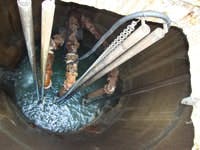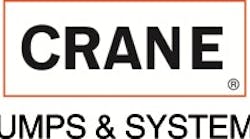A little more than three years ago, Crane Pumps & Systems Submersible Product team met with a group of water treatment operators and managers to discuss a growing problem—clogged wastewater treatment pumps and the tradeoffs between efficiency and non-clog capabilities.
The downtime and repair costs that municipalities incurred as a result of clogged pumps were on the rise. New solids and a reduction of water entering the waste stream were changing the game. As a result, high-efficiency pumps clogged incessantly—demanding the expensive cost of dispatching repair crews to lift the submersible pumps and clean them out by hand. Even pumps classified as non-clog were failing. As one frustrated operator said during a meeting, “How efficient is a clogged pump?”
It is a question municipalities are facing with increasing regularity: How cost-effective is a high-efficiency pump that consistently clogs or a non-clog pump that fails to live up to its name? When you do the math comparing the operational savings of a high-efficiency pump against the expense of a clog repair, the answer is immediate. One or two clogs and you are already losing; and the number multiplies with each clog.
“There’s a tradeoff between pump efficiency and solids-handling capability,” said Chuck Drake, submersible product manager for Crane Pumps & Systems. “We have a calculator on our website that lays out those costs in detail. So, based on the feedback we received from customers, we went to the drawing board to develop a product line focused specifically on clog resistance.”
Defining the Problem
Addressing the problem begins with understanding that there is no such thing as typical household waste. Our landscape, population and ways of life are diverse. U.S. household waste can come from coastal regions, mountains, desert and plains comprised of crowded urban areas, moderately populated suburban neighborhoods and sparsely occupied rural communities.
Because every community presents its own unique challenges, there is no one-size-fits-all solution. Even within communities there are differences. Does the waste stream include factories, schools or nursing facilities, which generate high solid loads? Or is it mainly a collection of suburban neighborhoods that are light on solids?
Therefore, understanding the pump capability needed for a particular area and matching the right pump to meet that need is the key to real cost-effectiveness. Placing a high-efficiency pump in an area that generates high- solids content is a recipe for disaster.
The Changing Green Scene
Water consumption is down and consumers are growing more environmentally responsible. Energy-efficient washing machines, dishwashers, toilets and showerheads send less water into the waste stream. This actually creates a problem for wastewater treatment because a certain level of water is necessary to maintain flow.
At the same time the water level is decreasing, the solid content level is increasing because consumers are assured by product marketers that certain rags, wipes and cleaning pads are safe to flush. True, perhaps, when flushing individual products; however, water treatment professionals know that all those individual products bunch together in the waste stream. And when they do, it clogs pumps. More and more “flushable” products are hitting the shelves and consequently, the wastewater stream.
Industry Standards
To handle everything consumers throw at it, literally, the water treatment industry strives to maintain two important standards. First, pump design should include enough clearance to pass a formable 3-in. solid. Second, it should generate enough force to maintain a flow rate of 2 ft per second for horizontal pipe and 3 ft per second for vertical pipe. Sacrifice either of these standards and you are headed for trouble.
Reducing these standards is a temptation that manufacturers face, however, when striving for maximum operational pump efficiency or possibly to lower costs. They do, of course, boast impressive operational efficiency numbers. But the numbers go south and then some when the pump clogs. That is why all CP&S Barnes pumps were designed to pass both tests.
Maintaining standards was simply a starting point for Drake and his team. They were determined to make a series of non-clog pumps that delivered, producing three designs that present a choice in levels of power and efficiency.
Mobile Home Treatment Success
Highland Treatment Inc., a contractor working with the wastewater treatment plant at a mobile home community in Holly, Mich., was frustrated by the constant clogging of a pump located in the system’s equalization basin. The pump, which transfers large raw sewage solids from the basin to a batch reactor, clogged constantly and the motor overheated and failed twice. Highland Treatment Inc. had to invest in extensive dedicated resources to keep the station operating.
Frustrated by the multiple clogs at the station, Highland installed a CP&S Barnes Vortex non-clog to replace the existing pump. The CP&S Barnes slotted discharge angle fit the existing discharge piping so no modifications were needed. To the community’s delight, the CP&S Barnes Vortex pump operated flawlessly. In fact, it has not clogged once since installation.
“We haven’t had to pull the pump since the day we put it in,” said Operations Supervisor Mark Dowson. “It’s just been maintenance free.”
“Our goal was to resolve the issues of our customers by delivering a non-clog pump that is reliable and clog free,” Drake said. “We’ve accomplished that goal with products for both gravity and pressure sewer systems. That’s what delivers real value.”
Download: Here


